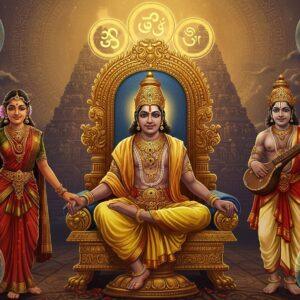
Vaisheshika, an ancient Indian philosophy, significantly impacted scientific thought with its unique atomic theory. This school of thought, attributed to Sage Kanada, introduced the concept of ‘anu,’ or atoms, as the fundamental, indivisible building blocks of matter. This blog delves into how these early ideas, originating around the 6th century BCE, influenced the trajectory of modern science.
Understanding Vaisheshika’s Atomic Theory
Vaisheshika’s atomic theory posits that the universe comprises atoms (anu) and void. It categorizes all existence into six padarthas (categories): substance, quality, activity, generality, particularity, and inherence. ‘Anu’ are described as eternal, indivisible particles, a concept remarkably similar to modern atomic theory. While sharing some similarities with the ancient Greek philosophies of Democritus and Leucippus, Vaisheshika offers a distinct perspective. The theory also delves into ‘dvyanuka’ (diatomic) and ‘tryanuka’ (triatomic) combinations, demonstrating an early understanding of molecular structures and foreshadowing modern concepts of molecules.
Beyond the physical, Vaisheshika’s atomic theory explores the philosophical implications of atomism, probing the nature of reality and perception, and prompting us to contemplate the fundamental nature of existence. You can delve deeper into related concepts by exploring our articles on Hindu scriptures and Vastu Shastra. Hindu Scriptures: A Detailed Exploration and Vastu Shastra: Principles and Practices of Ancient Indian Architecture offer further insights.
Vaisheshika Sutra: Exploring Laws of Motion
Sage Kanada’s Vaisheshika Sutra also explores the concept of motion. Central to this exploration are the ideas of ‘samyoga’ (contact) and ‘vibhaga’ (separation) as forces influencing movement. This resonates with modern understandings of force and momentum. The Sutra introduces the concept of motion transfer through impact, a principle akin to Newton’s Third Law of Motion.
Vaisheshika views motion as an interplay between atoms and their inherent tendencies, mirroring the concept of inertia in classical mechanics. The cessation of motion is attributed to resistance and counteracting forces, similar to modern concepts of friction and equilibrium. The Sutra also introduces ‘adrishta,’ or unseen forces, to explain phenomena lacking apparent causes, suggesting an early grappling with the concept of causality. These insights from the Vaisheshika Sutra significantly influenced later Indian thought, particularly in the fields of mechanics and dynamics. For further exploration on related cultural influences, see our blog post on the Ramayana’s Enduring Influence on Indian Culture.
Vaisheshika Sutra: Understanding Gravity
Vaisheshika offers an early understanding of gravity, proposing that objects naturally move towards the earth, a concept reminiscent of gravitational attraction. The term ‘guru-tva,’ denoting a natural heaviness or weight, further alludes to this gravitational pull. Predating Newton’s formalization of gravitational theory, Vaisheshika’s perspective on gravity extended to explaining planetary motion and cosmic order, demonstrating an awareness of the pervasive influence of gravitational forces.
These insights profoundly shaped subsequent developments in Indian astronomy and cosmology. Vaisheshika’s emphasis on an inherent cosmic order suggests an early recognition of natural laws governing the universe. This legacy of understanding gravity continues to resonate with contemporary scientific thought, highlighting the enduring influence of ancient wisdom on modern scientific exploration. For a broader understanding of Hinduism and its practices, you can refer to Exploring Hinduism: Core Beliefs and Practices.
How Poojn.in Connects You with Vaisheshika’s Legacy
At Poojn.in, we offer a curated collection of authentic ritual items that honor the scientific and spiritual legacy of Vaisheshika philosophy. Our offerings include:
- Pure copper and brass vessels: Ideal for ritual offerings, these vessels reflect Vaisheshika’s emphasis on the properties of substances. We offer a variety of sizes and designs to suit your needs. Brass Chand Mala are amongst many. Find what speaks to your practice best.
- Traditional meditation aids: Support your contemplation of atomic principles and the nature of reality with our selection of meditation aids. Original Athizay Stone Shiva Lingam and Nandi Set is one such aid. We provide a variety of cushions, beads, and other aids to deepen your practice.
- Natural incense and dhoop: Crafted from elemental substances, our incense and dhoop enhance your connection to the natural world. We provide Aroma Aguru amongst other incenses. Each is designed to help create an atmosphere of serenity.
- Puja thalis: Our puja thalis are crafted with authentic metals according to traditional specifications, ensuring the highest standards of purity and craftsmanship for your rituals. Iron Kharu are available to facilitate deep and meaningful connections.
- Camphor: Enhance your spiritual practices with our selection of high-quality camphor.
We offer secure, trackable delivery across India. Visit www.poojn.in to explore our full range. Our customer service team is available to assist you in selecting the perfect items for your spiritual journey.
Shop Now for Authentic Puja Items
Conclusion: The Enduring Legacy of Vaisheshika
Vaisheshika’s insights into atomic theory, laws of motion, and gravity provide a glimpse into the richness of India’s ancient intellectual heritage. Sage Kanada’s work, as captured in the Vaisheshika Sutra, laid the groundwork for scientific inquiry, with principles that resonate with many concepts in modern science, including Newton’s laws and gravitational theory. Vaisheshika stands as a testament to the profound curiosity and intellectual depth of early Indian scholars.
This foundational knowledge influenced not only Indian philosophy but also enriched the global scientific heritage. Vaisheshika’s legacy reminds us of the timeless human pursuit of knowledge, bridging the past with the present and demonstrating how ancient ideas continue to shape our understanding of the world. Embracing this wisdom allows for a deeper appreciation of the interconnectedness of tradition, philosophy, and scientific exploration.
FAQs on Vaisheshika and Its Scientific Impact
What is Vaisheshika Atomic Theory? Vaisheshika Atomic Theory, developed around the 6th century BCE, proposes that the universe is composed of indivisible particles called ‘anu’ (atoms). These particles combine to form different substances, a concept that predates John Dalton’s atomic theory by centuries.
How did Vaisheshika influence modern science? Vaisheshika’s ideas, especially its atomic theory and concepts of motion and gravity, laid a foundational understanding of the nature of matter and forces. This encouraged scientific inquiry and exploration, influencing later scientific developments.
What are the Vaisheshika Sutra Laws of Motion? The Vaisheshika Sutra introduces concepts of motion, force, and impact that parallel aspects of Newton’s laws. It discusses ‘samyoga’ (contact) and ‘vibhaga’ (separation) as crucial in influencing movement, resembling modern ideas of force and momentum. It also introduces motion transfer through impact, a concept similar to Newton’s Third Law of Motion.
How does Vaisheshika Sutra explain gravity? Vaisheshika introduces the concept of ‘guru-tva’, which denotes a natural heaviness or weight, hinting at a concept similar to gravitational pull. This conceptualization represents an early attempt to understand why objects fall towards the earth.
Why is Vaisheshika important in scientific thought? Vaisheshika promoted observation, inference, and logical reasoning as valid means of acquiring knowledge (Pramana), thus encouraging a systematic approach to understanding the natural world. This laid a foundation for scientific inquiry and experimentation.
Did Vaisheshika’s ideas spread to other cultures? While primarily rooted in ancient Indian thought, Vaisheshika’s concepts, especially its atomic theory, likely interacted with and influenced other philosophical and scientific traditions through trade and cultural exchanges.
Are Vaisheshika’s ideas still relevant today? Vaisheshika’s emphasis on a logical and systematic approach to understanding the universe remains relevant. Its historical significance and its early exploration of fundamental concepts continue to inspire scientific thought and provide valuable context for modern scientific understanding.


